+ Open data
Open data
- Basic information
Basic information
| Entry | Database: EMDB / ID: EMD-24500 | |||||||||
|---|---|---|---|---|---|---|---|---|---|---|
| Title | Structure of CX3CL1-US28-Gi-scFv16 in C-state | |||||||||
 Map data Map data | Full sharpen map. | |||||||||
 Sample Sample |
| |||||||||
 Keywords Keywords | Viral GPCR / HCMV / cytomegalovirus / G protein complex / MEMBRANE PROTEIN | |||||||||
| Function / homology |  Function and homology information Function and homology informationCXCR1 chemokine receptor binding / positive regulation of calcium-independent cell-cell adhesion / negative regulation of interleukin-1 alpha production / leukocyte adhesive activation / CX3C chemokine receptor binding / negative regulation of glutamate receptor signaling pathway / autocrine signaling / lymphocyte chemotaxis / synapse pruning / positive regulation of microglial cell migration ...CXCR1 chemokine receptor binding / positive regulation of calcium-independent cell-cell adhesion / negative regulation of interleukin-1 alpha production / leukocyte adhesive activation / CX3C chemokine receptor binding / negative regulation of glutamate receptor signaling pathway / autocrine signaling / lymphocyte chemotaxis / synapse pruning / positive regulation of microglial cell migration / regulation of lipopolysaccharide-mediated signaling pathway / negative regulation of microglial cell activation / negative regulation of neuron migration / negative regulation of hippocampal neuron apoptotic process / positive regulation of transforming growth factor beta1 production / CCR chemokine receptor binding / microglial cell proliferation / positive regulation of actin filament bundle assembly / leukocyte migration involved in inflammatory response / integrin activation / C-C chemokine receptor activity / chemokine-mediated signaling pathway / eosinophil chemotaxis / C-C chemokine binding / leukocyte chemotaxis / angiogenesis involved in wound healing / chemokine activity / Chemokine receptors bind chemokines / negative regulation of interleukin-1 beta production / positive regulation of cell-matrix adhesion / neuron remodeling / symbiont-mediated transformation of host cell / positive regulation of neuroblast proliferation / positive chemotaxis / chemoattractant activity / macrophage chemotaxis / negative regulation of interleukin-6 production / negative regulation of apoptotic signaling pathway / negative regulation of tumor necrosis factor production / negative regulation of cell-substrate adhesion / regulation of neurogenesis / negative regulation of extrinsic apoptotic signaling pathway in absence of ligand / adenylate cyclase inhibitor activity / positive regulation of protein localization to cell cortex / T cell migration / Adenylate cyclase inhibitory pathway / D2 dopamine receptor binding / response to prostaglandin E / adenylate cyclase regulator activity / G protein-coupled serotonin receptor binding / adenylate cyclase-inhibiting serotonin receptor signaling pathway / neutrophil chemotaxis / extrinsic apoptotic signaling pathway in absence of ligand / positive regulation of smooth muscle cell proliferation / cellular response to forskolin / regulation of mitotic spindle organization / negative regulation of cell migration / positive regulation of release of sequestered calcium ion into cytosol / response to ischemia / cell chemotaxis / cell projection / Regulation of insulin secretion / calcium-mediated signaling / positive regulation of cholesterol biosynthetic process / microglial cell activation / negative regulation of insulin secretion / defense response / G protein-coupled receptor binding / cell-cell adhesion / positive regulation of neuron projection development / response to peptide hormone / adenylate cyclase-inhibiting G protein-coupled receptor signaling pathway / neuron cellular homeostasis / regulation of synaptic plasticity / adenylate cyclase-modulating G protein-coupled receptor signaling pathway / G-protein beta/gamma-subunit complex binding / centriolar satellite / integrin binding / Olfactory Signaling Pathway / Activation of the phototransduction cascade / G beta:gamma signalling through PLC beta / Presynaptic function of Kainate receptors / Thromboxane signalling through TP receptor / G protein-coupled acetylcholine receptor signaling pathway / positive regulation of angiogenesis / Activation of G protein gated Potassium channels / Inhibition of voltage gated Ca2+ channels via Gbeta/gamma subunits / cytokine-mediated signaling pathway / G-protein activation / chemotaxis / Prostacyclin signalling through prostacyclin receptor / G beta:gamma signalling through CDC42 / Glucagon signaling in metabolic regulation / positive regulation of inflammatory response / G beta:gamma signalling through BTK / Synthesis, secretion, and inactivation of Glucagon-like Peptide-1 (GLP-1) / ADP signalling through P2Y purinoceptor 12 / photoreceptor disc membrane / antimicrobial humoral immune response mediated by antimicrobial peptide / Sensory perception of sweet, bitter, and umami (glutamate) taste Similarity search - Function | |||||||||
| Biological species |  Homo sapiens (human) / Homo sapiens (human) /    Human betaherpesvirus 5 Human betaherpesvirus 5 | |||||||||
| Method | single particle reconstruction / cryo EM / Resolution: 3.5 Å | |||||||||
 Authors Authors | Tsutsumi N / Qu Q | |||||||||
| Funding support |  United States, 2 items United States, 2 items
| |||||||||
 Citation Citation |  Journal: Sci Adv / Year: 2022 Journal: Sci Adv / Year: 2022Title: Atypical structural snapshots of human cytomegalovirus GPCR interactions with host G proteins Authors: Tsutsumi N / Maeda S / Qu Q / Voegele M / Jude KM / Suomivuori CM / Panova O / Waghray D / Kato HE / Velasco A / Dror RO / Skiniotis G / Kobilka BK / Garcia KC | |||||||||
| History |
|
- Structure visualization
Structure visualization
| Movie |
 Movie viewer Movie viewer |
|---|---|
| Structure viewer | EM map:  SurfView SurfView Molmil Molmil Jmol/JSmol Jmol/JSmol |
| Supplemental images |
- Downloads & links
Downloads & links
-EMDB archive
| Map data |  emd_24500.map.gz emd_24500.map.gz | 9.1 MB |  EMDB map data format EMDB map data format | |
|---|---|---|---|---|
| Header (meta data) |  emd-24500-v30.xml emd-24500-v30.xml emd-24500.xml emd-24500.xml | 22.6 KB 22.6 KB | Display Display |  EMDB header EMDB header |
| Images |  emd_24500.png emd_24500.png | 76.8 KB | ||
| Filedesc metadata |  emd-24500.cif.gz emd-24500.cif.gz | 7.4 KB | ||
| Archive directory |  http://ftp.pdbj.org/pub/emdb/structures/EMD-24500 http://ftp.pdbj.org/pub/emdb/structures/EMD-24500 ftp://ftp.pdbj.org/pub/emdb/structures/EMD-24500 ftp://ftp.pdbj.org/pub/emdb/structures/EMD-24500 | HTTPS FTP |
-Validation report
| Summary document |  emd_24500_validation.pdf.gz emd_24500_validation.pdf.gz | 361.6 KB | Display |  EMDB validaton report EMDB validaton report |
|---|---|---|---|---|
| Full document |  emd_24500_full_validation.pdf.gz emd_24500_full_validation.pdf.gz | 361.2 KB | Display | |
| Data in XML |  emd_24500_validation.xml.gz emd_24500_validation.xml.gz | 6.5 KB | Display | |
| Data in CIF |  emd_24500_validation.cif.gz emd_24500_validation.cif.gz | 7.5 KB | Display | |
| Arichive directory |  https://ftp.pdbj.org/pub/emdb/validation_reports/EMD-24500 https://ftp.pdbj.org/pub/emdb/validation_reports/EMD-24500 ftp://ftp.pdbj.org/pub/emdb/validation_reports/EMD-24500 ftp://ftp.pdbj.org/pub/emdb/validation_reports/EMD-24500 | HTTPS FTP |
-Related structure data
| Related structure data |  7rkmMC  7rkfC  7rknC  7rkxC  7rkyC M: atomic model generated by this map C: citing same article ( |
|---|---|
| Similar structure data |
- Links
Links
| EMDB pages |  EMDB (EBI/PDBe) / EMDB (EBI/PDBe) /  EMDataResource EMDataResource |
|---|---|
| Related items in Molecule of the Month |
- Map
Map
| File |  Download / File: emd_24500.map.gz / Format: CCP4 / Size: 125 MB / Type: IMAGE STORED AS FLOATING POINT NUMBER (4 BYTES) Download / File: emd_24500.map.gz / Format: CCP4 / Size: 125 MB / Type: IMAGE STORED AS FLOATING POINT NUMBER (4 BYTES) | ||||||||||||||||||||||||||||||||||||||||||||||||||||||||||||
|---|---|---|---|---|---|---|---|---|---|---|---|---|---|---|---|---|---|---|---|---|---|---|---|---|---|---|---|---|---|---|---|---|---|---|---|---|---|---|---|---|---|---|---|---|---|---|---|---|---|---|---|---|---|---|---|---|---|---|---|---|---|
| Annotation | Full sharpen map. | ||||||||||||||||||||||||||||||||||||||||||||||||||||||||||||
| Projections & slices | Image control
Images are generated by Spider. | ||||||||||||||||||||||||||||||||||||||||||||||||||||||||||||
| Voxel size | X=Y=Z: 0.82 Å | ||||||||||||||||||||||||||||||||||||||||||||||||||||||||||||
| Density |
| ||||||||||||||||||||||||||||||||||||||||||||||||||||||||||||
| Symmetry | Space group: 1 | ||||||||||||||||||||||||||||||||||||||||||||||||||||||||||||
| Details | EMDB XML:
CCP4 map header:
| ||||||||||||||||||||||||||||||||||||||||||||||||||||||||||||
-Supplemental data
- Sample components
Sample components
+Entire : CX3CL1-US28-Gi-scFv16 complex
+Supramolecule #1: CX3CL1-US28-Gi-scFv16 complex
+Supramolecule #2: Gi heterotrimer
+Supramolecule #3: scFv16
+Supramolecule #4: CX3CL1-US28
+Macromolecule #1: Guanine nucleotide-binding protein G(i) subunit alpha-1
+Macromolecule #2: Guanine nucleotide-binding protein G(I)/G(S)/G(T) subunit beta-1
+Macromolecule #3: Guanine nucleotide-binding protein G(I)/G(S)/G(O) subunit gamma-2
+Macromolecule #4: Antibody fragment scFv16
+Macromolecule #5: Fractalkine
+Macromolecule #6: G-protein coupled receptor homolog US28
+Macromolecule #7: CHOLESTEROL
-Experimental details
-Structure determination
| Method | cryo EM |
|---|---|
 Processing Processing | single particle reconstruction |
| Aggregation state | particle |
- Sample preparation
Sample preparation
| Concentration | 30 mg/mL | ||||||||||||
|---|---|---|---|---|---|---|---|---|---|---|---|---|---|
| Buffer | pH: 7.2 Component:
| ||||||||||||
| Grid | Model: Quantifoil R1.2/1.3 / Material: GOLD / Mesh: 200 / Pretreatment - Type: GLOW DISCHARGE | ||||||||||||
| Vitrification | Cryogen name: ETHANE / Chamber humidity: 100 % / Chamber temperature: 295 K / Instrument: FEI VITROBOT MARK IV / Details: 1 s blotting before plunging. |
- Electron microscopy
Electron microscopy
| Microscope | FEI TITAN KRIOS |
|---|---|
| Specialist optics | Energy filter - Name: GIF Bioquantum / Energy filter - Slit width: 20 eV |
| Image recording | Film or detector model: GATAN K2 SUMMIT (4k x 4k) / Detector mode: SUPER-RESOLUTION / Number grids imaged: 1 / Number real images: 4546 / Average electron dose: 83.0 e/Å2 Details: The same specimen/movie data as the OC-state CX3CL1-US28-Gi-scFv16 (7RKM). |
| Electron beam | Acceleration voltage: 300 kV / Electron source:  FIELD EMISSION GUN FIELD EMISSION GUN |
| Electron optics | Calibrated magnification: 60976 / Illumination mode: FLOOD BEAM / Imaging mode: BRIGHT FIELD / Cs: 2.7 mm / Nominal defocus max: -2.0 µm / Nominal defocus min: -1.0 µm / Nominal magnification: 165000 |
| Sample stage | Specimen holder model: FEI TITAN KRIOS AUTOGRID HOLDER / Cooling holder cryogen: NITROGEN |
| Experimental equipment |  Model: Titan Krios / Image courtesy: FEI Company |
+ Image processing
Image processing
-Atomic model buiding 1
| Refinement | Space: REAL / Protocol: FLEXIBLE FIT |
|---|---|
| Output model |  PDB-7rkm: |
 Movie
Movie Controller
Controller









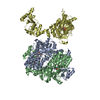
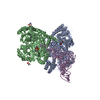

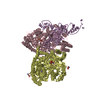
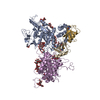
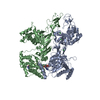
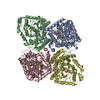





























 Z (Sec.)
Z (Sec.) Y (Row.)
Y (Row.) X (Col.)
X (Col.)





















 Trichoplusia ni (cabbage looper)
Trichoplusia ni (cabbage looper)
